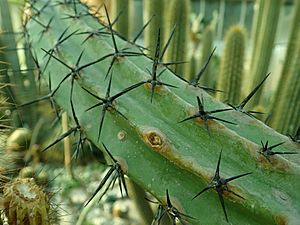Candelabra cactus facts for kids
Quick facts for kids Candelabra cactus |
|
|---|---|
 |
|
| Spines | |
 |
|
| At the Jardin Exotique de Monaco | |
| Conservation status | |
| Scientific classification | |
| Genus: |
Myrtillocactus
|
| Species: |
cochal
|
| Synonyms | |
|
|
The candelabra cactus (Myrtillocactus cochal) is a really interesting flowering plant. It belongs to the Cactaceae family, which is the big group of plants we call cacti! This special cactus gets its name because it often grows in a shape that looks like a candelabra, which is a fancy candlestick with many arms.
You can find the candelabra cactus growing naturally in Baja California, a long peninsula in Mexico. It's a plant that's native to that area, meaning it grew there all on its own for a very long time.
What Does It Look Like?
The candelabra cactus can grow quite tall, reaching up to about 3 meters (that's almost 10 feet!). Imagine a cactus taller than most grown-ups! It has many branches that spread out, giving it that candelabra shape.
Like many cacti, it has spines. These are like tiny, sharp needles that help protect the plant from animals that might want to eat it. The spines also help the cactus collect dew and moisture from the air.
Where Does It Grow?
This cactus loves warm, dry places. It's found in the desert and semi-desert areas of Baja California. It's very good at living in places where there isn't much water.
The candelabra cactus is pretty tough! It can survive in areas where the temperature doesn't usually drop below freezing for too long. Scientists use something called "USDA hardiness zones" to describe where plants can grow. This cactus is hardy to USDA zone 9b, which means it can handle certain cooler temperatures without getting damaged.
Why Is It Important?
Like all plants, the candelabra cactus plays an important role in its ecosystem. It provides food and shelter for various desert animals. Its flowers can also attract pollinators like bees and other insects.
This cactus is also a great example of how plants adapt to their environment. Its tall, branching shape and ability to store water help it survive in the dry desert conditions of Baja California.
See also
 In Spanish: Myrtillocactus cochal para niños
In Spanish: Myrtillocactus cochal para niños


